Poha Recipe (Spiced Flattened Rice)
Updated: August 29, 2022, By Swasthi
Poha Recipe in 2 ways! Make soft and delicious poha with my easy recipe. Poha also known as Pohe is a quick Indian Breakfast made with flattened rice, onions, spices, herbs, lemon juice & peanuts. In this post I show you how to make poha in just 20 mins. It’s refreshing, lemony and you will simply love it. Serve poha as is or top it with some crunchy sev, fresh cut onions or with grated coconut. To make it a complete meal, serve it with plain yogurt and vegetable salad on the side.
If you are new to Indian regional cuisines & wondering
What is Poha?
Poha is flattened rice that is steam cooked with onions, spices and herbs. The word “poha” refers to the flattened rice itself and as well the dish made with it. These flattened rice flakes are also known as parched rice or beaten rice. They are considered to be nutritious & wholesome as they are got by minimally processing paddy.
So flattened rice is used widely across India to make various dishes like chivda, upma, dosa, idli and many more. Among the most commonly eaten is this dish POHA. This nutritious traditional food is eaten in many regions of India & surprisingly there are numerous ways to make it.
It is eaten for breakfast, snack & even for a quick dinner. It can also be taken to school or work in lunch box.
This simple dish does not need any accompaniment. But it is usually garnished and topped with various ingredients like sev, raw onions or fresh coconut.
About My Poha Recipes
The first one is the Maharashtrian Kanda batata poha recipe which we make often for our breakfast. Here Kanda translates to onions and Batata to potato in Marathi. So this one is made with onions and potatoes. You can use both or skip any one of them. Or replace potatoes with some green peas.
I prefer to use potatoes as my kids love them in their poha. You can either use boiled/ steamed potatoes or use them raw directly and cook in the pan.
I have followed the later method here. But if you have trouble cooking your potatoes quickly, then it is good to use them boiled.
The second recipe is for dadpe pohe which is more common in the Konkan region. This recipe needs fresh coconut and is quick to make like the first one. I have been making this in the recent times for a change.
Another popular version is the Indori poha which I am yet to share. The use of fennel seeds make it very distinct in flavor from the Maharashtrian version. It is garnished the same way with sev & raw onions.
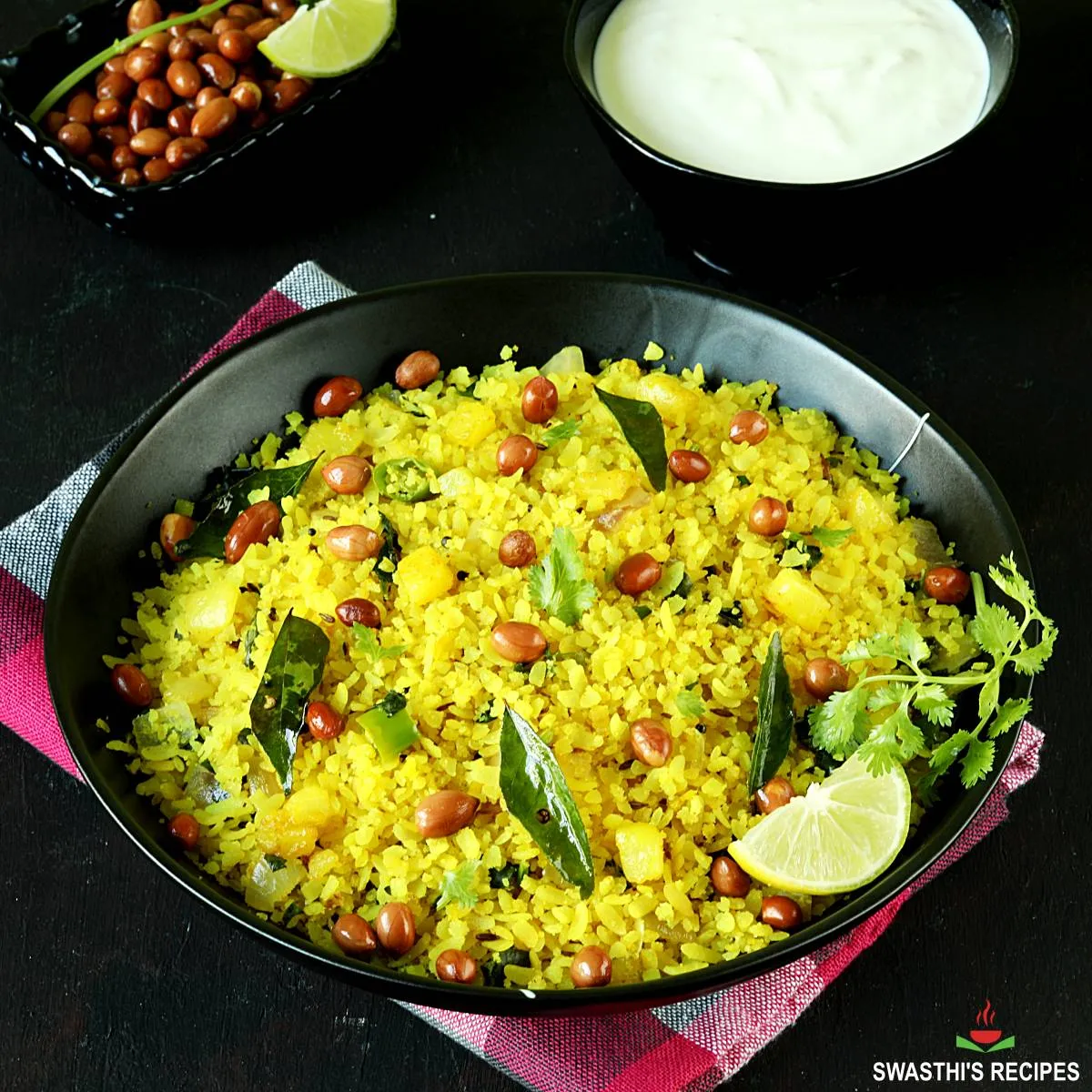
More Breakfast recipes,
Chilla recipe
Methi Thepla
Upma recipe
Rava idli
Semiya upma
Akki roti
Photo Guide
How to Make Poha (Stepwise Photos)
1. Clean 1½ cups poha and add them to a large colander, strainer or bowl or pot. Please note that to make non sticky poha, you will need to use thick or medium flakes. If you use thin flakes poha will turn mushy after rinsing them.
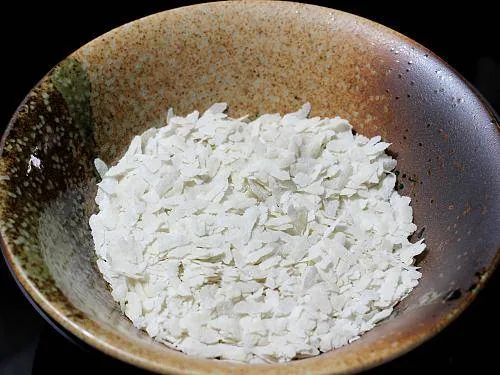
2. You have to be quick at this step as doing it slowly will make them too mushy and soggy. Rinse them well with clean filtered water. Drain the water completely. Repeat the rinse & drain the water completely. I usually rinse them twice but if you feel they turn too mushy after the first rinse then stop rinsing further. Keep the bowl aside.
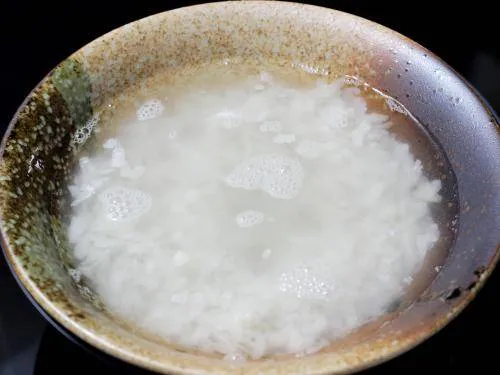
3. Meanwhile chop 1 medium sized onion and 1 to 2 green chilies. Also rinse the curry leaves and coriander leaves. Fine chop the coriander leaves. If you want to use potatoes then chop them to half inch cubes and keep them immersed in water until needed.
4. Check if poha has softened by pressing down a few flakes in between your thumb and fore finger. Run your finger across the flattened rice to break lumps if any. Poha would have absorbed water and softened in about 5 to 7 mins.
If they are not soft yet, then sprinkle some water and set aside until the tempering is ready. Make sure they do not turn mushy. Add salt and sugar (optional). Mix and set aside.
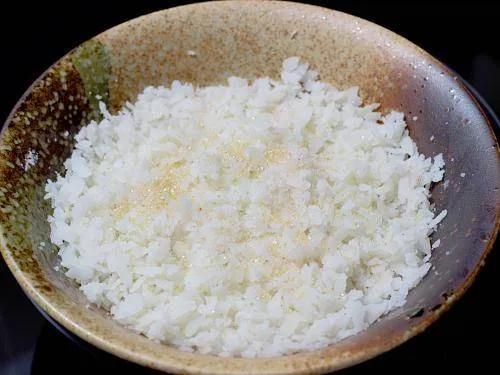
Temper for Poha
5. Heat a pan with ½ tablespoon oil and fry the peanuts until golden and crunchy. Set them aside for garnishing. This way the peanuts remain crunchy. You can also dry roast the peanuts if you prefer.
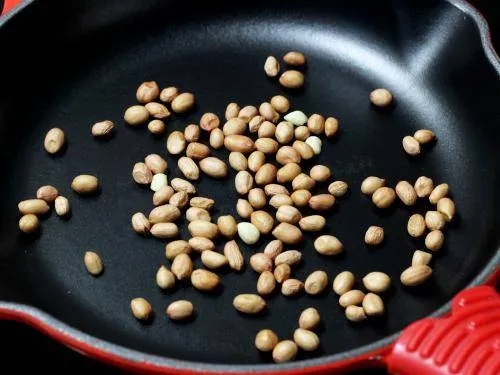
6. Heat the same pan with 1 to 1 ½ tablespoon oil. When the oil becomes hot, add ¾ teaspoon mustard seeds and ¾ teaspoon cumin seeds. Let them splutter.
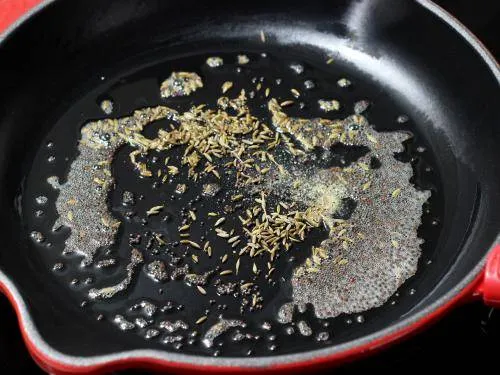
7. Add chopped onions, green chilies and curry leaves.
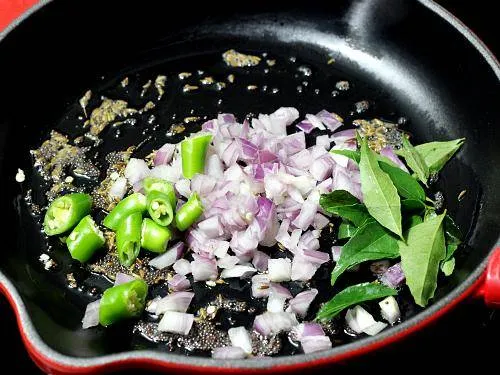
8. Saute until the onions turn pink. If using potatoes, drain the water completely and add the cubes to the pan. Saute for 2 to 3 minutes.
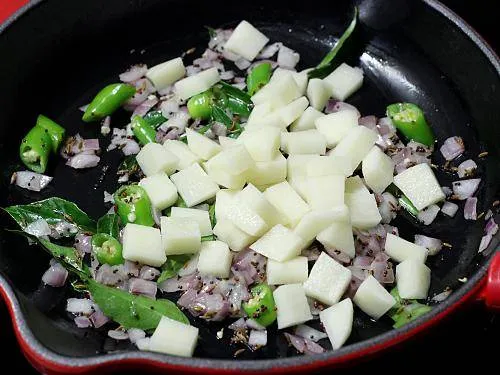
9. Cover the pan and cook on a low heat until the potatoes are soft cooked. If needed you may add more oil.
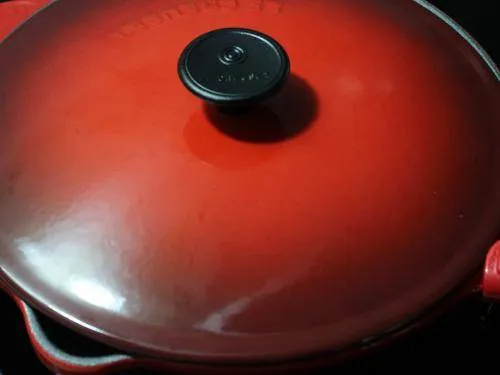
10. Once the potatoes are cooked thoroughly, you can saute them on a high flame for 1 to 2 mins. Add turmeric.
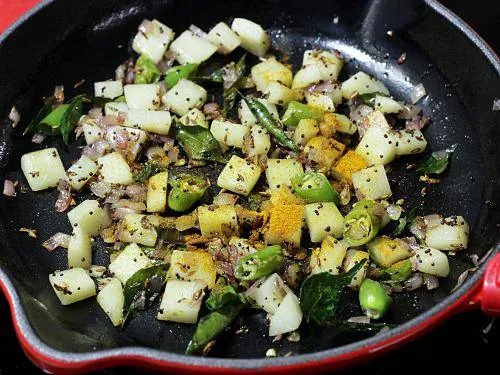
11. Add softened poha and mix well.
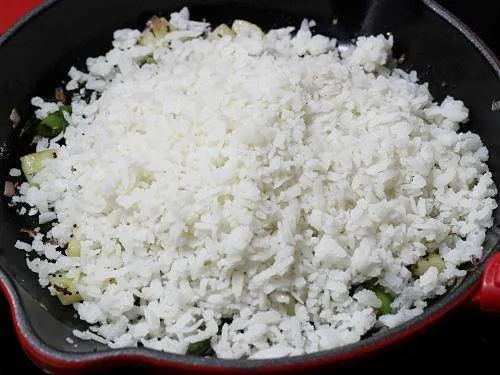
12. Cover and steam on a low heat until poha becomes hot. Stir in between to prevent burning. If you feel your poha is too dry, then you may sprinkle some water in between. When done it should be soft and not mushy. Sprinkle coriander leaves and roasted peanuts.
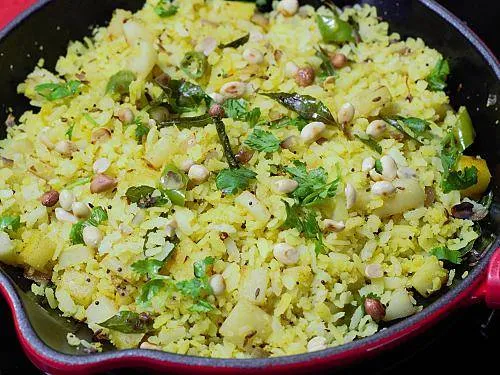
13. Take it off the heat. Taste and add more salt if needed. Add lemon juice and keep it covered until served.
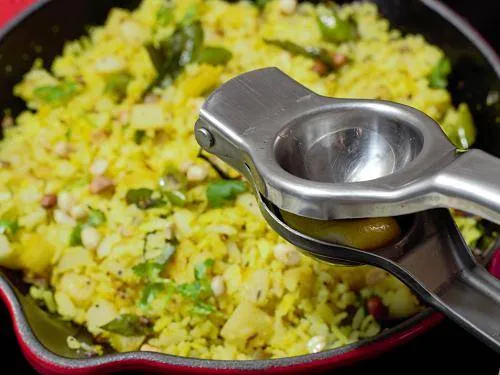
Garnish kanda batata poha with fine chopped coriander leaves and roasted peanuts. You can also sprinkle some grated coconut or crunchy sev.

Pro Tips
Choosing poha: Using the right kind of poha is very important for this recipe. Always choose medium to thick poha flakes and avoid the thin ones. The thin kind are not suitable to make this recipe as they turn mushy when rinsed.
Test your poha if you are a newbie: You can check simply by rinsing a spoonful of poha in little water and drain completely. If they do not turn mushy then they are very much suitable to use in this recipe.
If they turn mushy then you may use them to make dadpe pohe (recipe 2) instead.
Rinsing poha: Do not over rinse or over soak the poha otherwise they may turn mushy. I generally rinse them twice and drain the water completely. Cover and set aside until the tempering is ready.
After chopping the onions, check if the poha is soft by pressing a few flakes in between the thumb and the fore finger. They should break easily. If not then sprinkle some water. Mix and cover it till needed.
Veggies: To make it healthier and balanced you may add different kinds of fine chopped veggies like carrots, peas & capsicum. You can also skip the onions and use fine chopped cabbage. Blanch the cabbage in hot water for 2 to 3 mins and then add use them the same way like onions. Use whatever vegetables you like in your poha.
Toppings: Poha is generally topped with fresh grated coconut, crunchy peanuts, sev or farsan. It tastes pretty much delicious even with peanuts alone.
Make ahead
You can make this poha recipe ahead by simply preparing the tempering first. Cool, cover and keep the whole pan/pot in the fridge. When you are ready to eat your poha, simply rinse your flattened rice and soften them. Add them to the tempering and mix. Steam them on a low heat. Your poha will be ready in no time.
Photo Guide
Recipe 2
How to Make Dadpe Pohe
Dadpe pohe is made with much the same ingredients as kanda poha except for an additional ingredient, coconut. This is best to serve for a snack. In this recipe poha is not rinsed or steamed. It is eaten in the raw form but is softened. It tastes delicious with good flavors of fried curry leaves and green chilies.
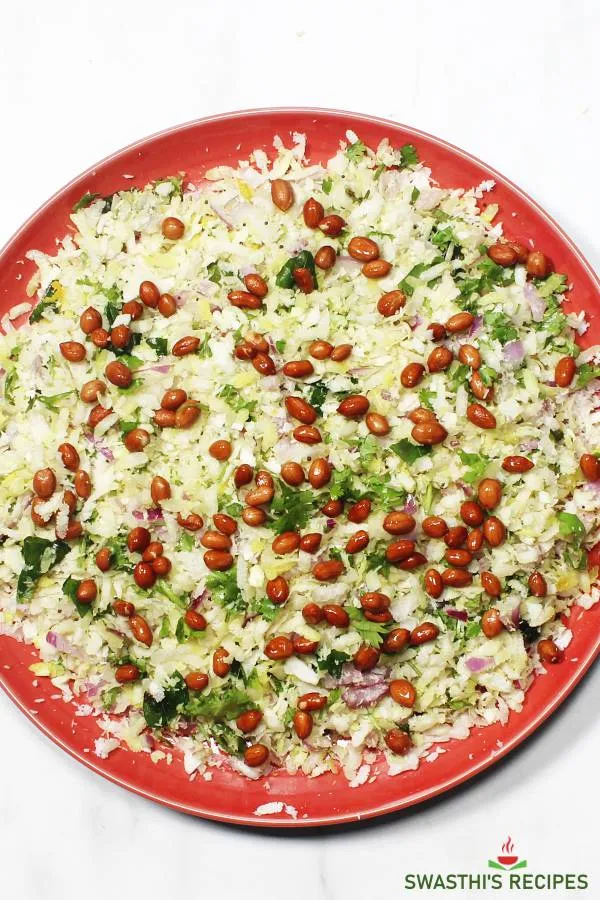
This is made by mixing chopped onions, fresh grated coconut, coriander leaves, lemon juice, poha, salt and sugar. To soften the poha, little coconut water or plain water is splashed.
Then a tempering of curry leaves, green chilies, mustard seeds and peanuts is poured to the mixture. It is covered so the dadpe pohe absorbs much of the tempering flavour.
This is even easier than the first recipe. Again there are different versions of this. Sometimes I add little grated cucumber, carrots and sometimes tomatoes too. This is best made with fresh coconut and medium poha.
Avoid using thin flakes and too thick flakes. Thinner flakes stick up and clump up. Too thick flakes won’t soften quickly. This recipe is kids’ friendly if you skip or reduce the green chilies. Here are the ingredients to make it.
Ingredients (serves 3)
2 cups poha (medium flakes)
¾ to 1 cup fresh grated coconut
1 medium onion (½ cup finely chopped)
1 to 2 green chilies (chopped, adjust to taste)
1/3 cup coriander leaves (fine chopped)
1 teaspoon powdered sugar (or fine sugar)
½ teaspoon salt (adjust to taste)
1 medium lemon (adjust to taste)
1 to 2 tablespoons coconut water or plain water
¼ to ½ teaspoon mustard seeds
1 tablespoon oil (more if needed)
2 sprigs curry leaves (torn or chopped)
1 pinch hing / asafoetida
1 to 2 pinches turmeric
¼ cup peanuts
Instructions for Dadpe Pohe
1. To begin with I sieve the poha so any fine powdery stuff can be easily separated. Then add them to a large plate. You will be making the dadpe poha in this.
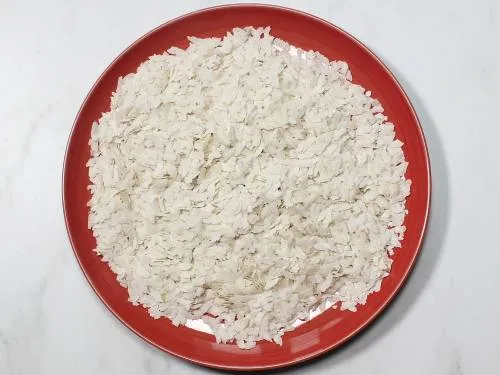
2. Add onions, grated coconut, salt, powdered or fine sugar, lemon juice and coriander leaves.
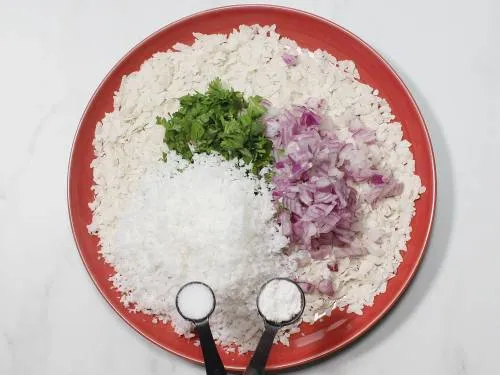
3. Mix all of them. You will see the poha is still dry. At this stage splash little coconut water or plain water if needed. Traditionally it is made with coconut water but plain water can be used. Give a good mix. Cover this and set aside until soft. If you think it is too dry sprinkle little more water. But take care not to add a lot else it will turn mushy.
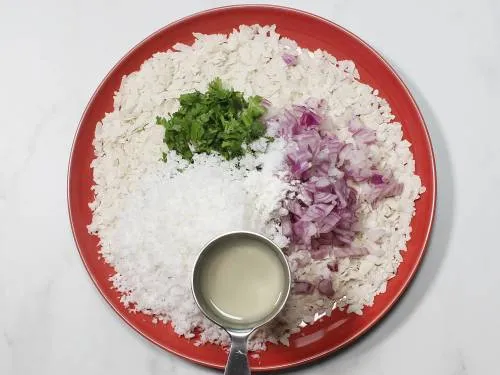
4. Taste test. Add more salt, sugar and lemon juice if needed. This is how mine looked after it softened. Cover this until soft for 5 to 10 mins. Onions and fresh coconut release some moisture so sprinkle more water only if needed after 10 minutes.
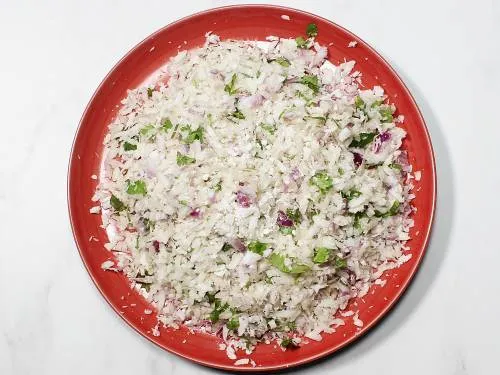
How to make
5. Pour 1½ tablespoon oil to a pan and heat it. When the oil becomes hot, add mustard seeds, chopped green chilies and torn curry leaves. When the curry leaves turn crisp, turn off. Add 1/8 teaspoon hing and a pinch of turmeric (optional).
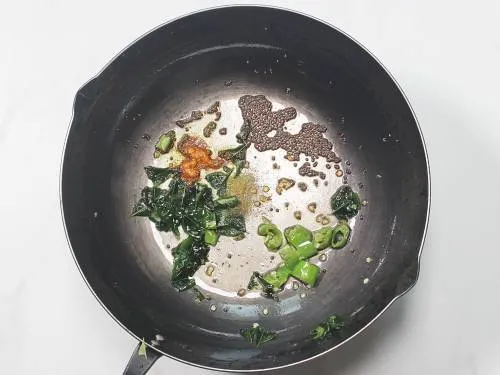
6. Pour this to the premixed poha. Cover it immediately so the flavors are absorbed.
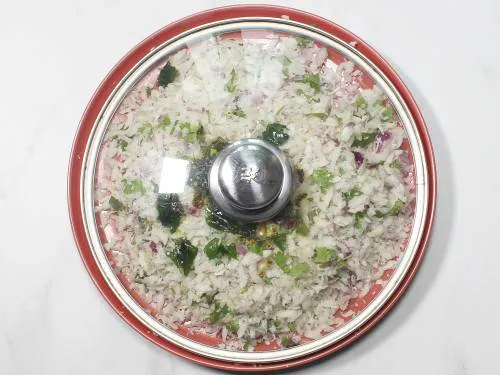
7. Meanwhile, roast the peanuts in the same pan until golden and crunchy. I do not prefer to do it with the tempering as the peanuts soften a bit when covered. Add these just before serving.
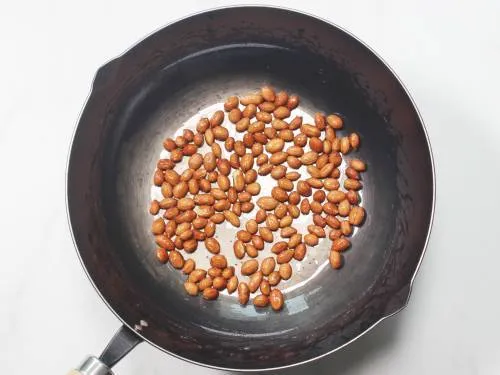
Let the dadpe pohe soften to your liking. We like ours a bit chewy and not too soft. If it is not soft then you may sprinkle little water or coconut water. Then transfer to serving bowls. Top with roasted peanuts.
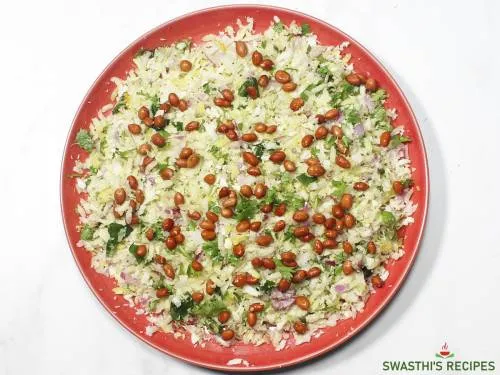
Faqs
Using thin flattened rice flakes, over rinsing or over soaking them will make your poha mushy.
Thicker flakes won’t soften quickly evenly after rinsing them a few times. Rehydrate them with a splash of water and let them rest until needed.
Yes poha is healthy as it is made by minimally processing paddy. To make flattened rice flakes, paddy is soaked, parboiled and then pressed to flatten & separate the husk. Since they are processed with the bran, most of the nutrients are said to be intact.
Yes flattened rice flakes are naturally gluten free. To make the dish gluten-free, skip asafoetida in the recipe or use one that is gluten-free.
Troubleshooting tips
These tips are helpful especially to those living outside India. There are different kinds of poha in the market. Not all are same and many times they are not the same even though they are from the same brand. Often we end up buying whatever is available. These troubleshooting tips will come handy in such times.
Some kinds of poha are too hard, too thick and dense. They remain hard even after rinsing several times under running water. They either need a short soak for 5 to 10 minutes or they need to be steamed properly for few minutes in a steamer or cooker.
I steam the hard brown poha for 3 minutes & hard white ones for 1 minute in my cooker. They come out fluffy & perfect without becoming mushy.
Sometimes poha turns completely mushy though they look like the medium thick flakes. Test a spoonful of flattened rice by rinsing first. If they are mushy, then are no good to be rinsed. Sprinkle water little by little and mix until all of the poha becomes damp. Set aside to soak & soften.
Related Recipes
Recipe Card
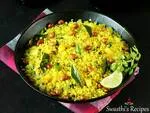
Poha Recipe
For best results follow the step-by-step photos above the recipe card
Ingredients (US cup = 240ml )
- 1 ½ cups poha (beaten rice flakes )(thick to medium flakes)
- 1 medium onion finely chopped
- 2 to 3 green chilies slit or chopped
- 1 sprig curry leaves
- 1 medium potato (optional) cubed to ½ inch (or ½ cup mix veggies)
- 1½ tablespoons oil
- 3 to 4 tablespoons peanuts or cashews
- ¾ teaspoon mustard seeds
- ¾ teaspoon cumin seeds (jeera)
- 1 pinch hing (asafoetida)
- ¼ teaspoon turmeric (add more if needed for color)
- ⅓ teaspoon salt (adjust to taste)
- ½ to 1 teaspoon sugar (optional)
- Lemon juice as needed
- 2 tablespoons coriander leaves chopped
Instructions
Preparation
- To make poha, choose medium to thick flakes. Avoid thin flakes. Add them to a bowl or a strainer or colander.
- Pour 4 to 5 cups of water and rinse them quickly. Drain the water completely. I rinse them twice.
- Cover and set aside to soften. Meanwhile prepare the veggies.
- Press a few flakes of poha in between your thumb and forefinger, they should be soft & break easily. If they don't then sprinkle little water mix and cover.
- When they turn soft enough, add some sugar and salt. Run your fingers through the poha to break the lumps & spread salt.
How to Make Poha
- Heat a pan with oil and fry the peanuts on a medium heat until golden and crunchy.
- Remove the peanuts to a plate and set aside.
- To the same pan add mustard and cumin.
- When they begin to pop, add hing, onions, curry leaves and green chilies.
- Saute until the onions turn lightly pink.
- Optional – Add cubed potatoes or mix veggies and saute for a min. Cover and cook on a low heat until soft and cooked completely. If needed can sprinkle some water and cook. Once done, saute for another minute.
- Add turmeric and poha. Mix well and cover the pan.
- Cook on a very low heat until it turns hot. If you feel poha is too dry, you may sprinkle some water and continue to steam.
- Turn off the heat when poha has softened & become hot. Remove from heat. Taste test and add more salt if needed & squeeze lemon juice.
- Garnish poha with coriander leaves & roasted peanuts. You may top with sev or farsan or fresh coconut. Serve it hot.
Make Dadpe Pohe
- Add 2 cups of poha to a wide plate along with ½ cup fine chopped onions, 1 cup fresh grated coconut, ½ teaspoon salt, 1 teaspoon fine sugar and ¼ cup fine chopped coriander leaves.
- Squeeze the juice out of 1 medium lemon and mix all of them with your hand. You may optionally add 1 to 2 tbsps of coconut water or plain water to soften them little more.
- Cover and set aside for 5 minutes until they soften. Onions and coconut will release some moisture and make the dadpe pohe soft.
- After 5 minutes, pour 1 tablespoon oil to a small tadka pan and heat it.
- Add ¼ to ½ teaspoon mustard seeds, 2 sprigs of torn curry leaves, 1 to 2 chopped green chilies. Fry all of them until the curry leaves turn crisp.
- Then add a pinch of hing and 1/8 teaspoon of turmeric. Pour this to the flattened rice mixture so it absorbs all of the flavors.
- Meanwhile add peanuts to the same pan and roast them until golden and crunchy. Once done set these aside to cool.
- Mix the poha well and taste test. If needed add more salt and lemon juice. If the poha is not soft to your liking you may add more coconut water or plain water and mix.
- Garnish dadpe pohe with fried peanuts.
Notes
- Always choose thick to medium variety poha. Thin poha is not suitable to make this recipe as they turn mushy when rinsed.
- If you are running short of time, just skip potatoes. You can also use boiled potatoes.
Video
NUTRITION INFO (estimation only)
© Swasthi’s Recipes
This post was first published in August 2016. Updated & republished in December 2020.
About Swasthi
I’m Swasthi Shreekanth, the recipe developer, food photographer & food writer behind Swasthi’s Recipes. My aim is to help you cook great Indian food with my time-tested recipes. After 2 decades of experience in practical Indian cooking I started this blog to help people cook better & more often at home. Whether you are a novice or an experienced cook I am sure Swasthi’s Recipes will assist you to enhance your cooking skills. More about me
Follow Swasthi’s Recipes
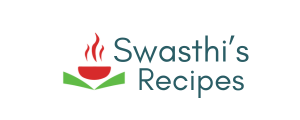
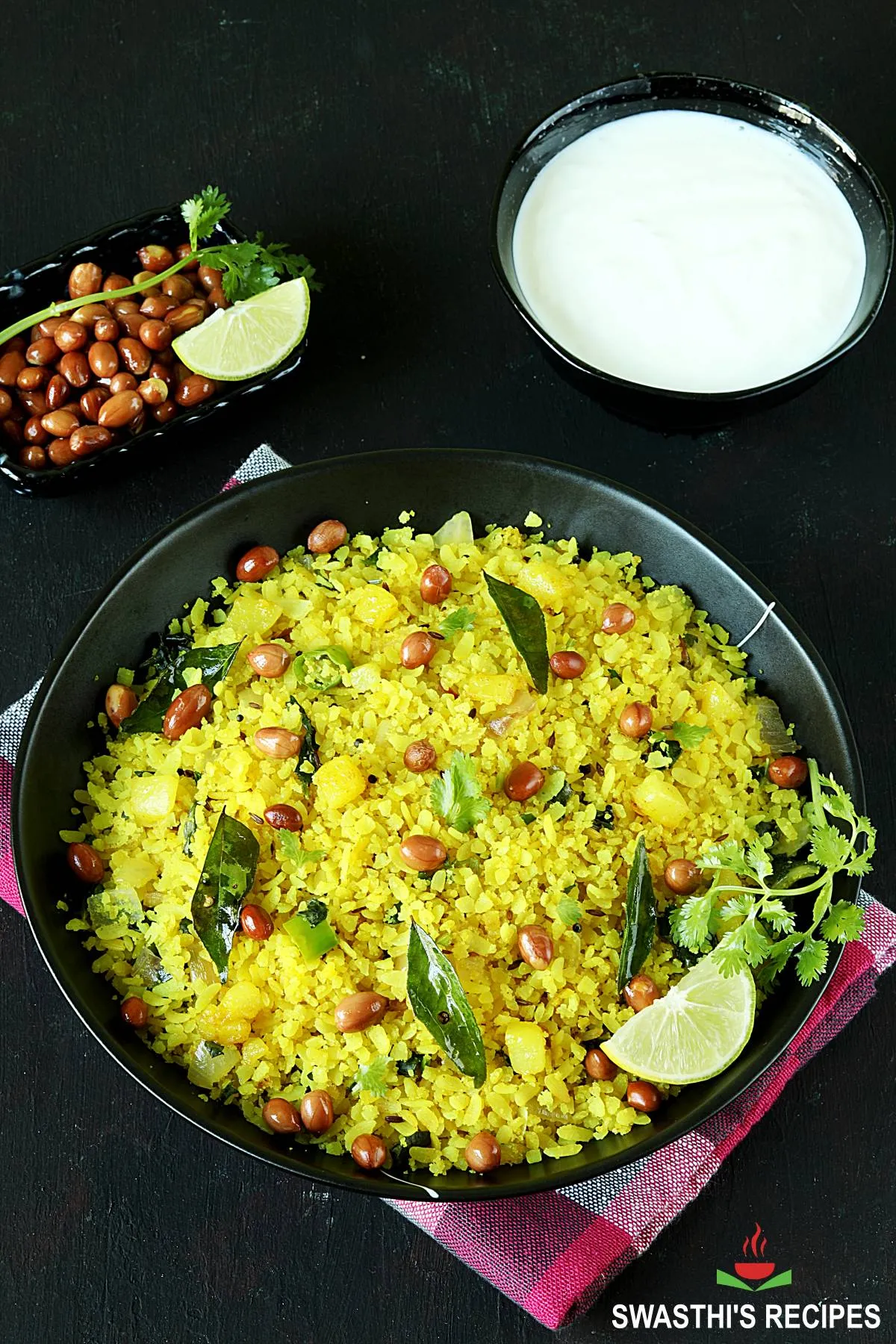
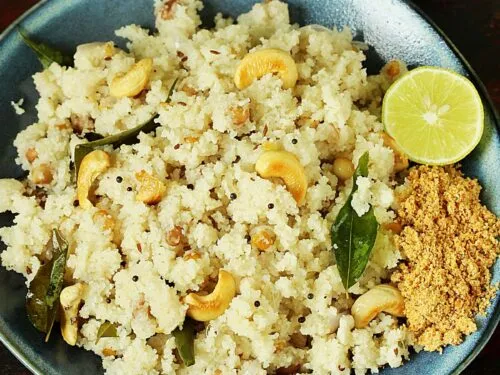
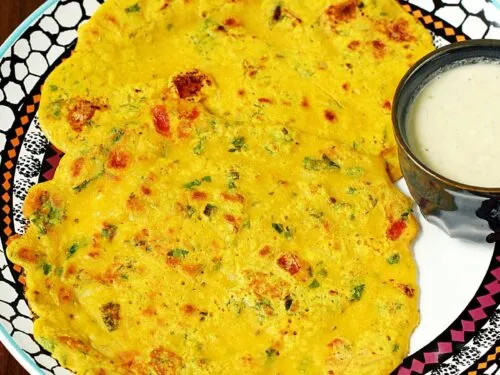
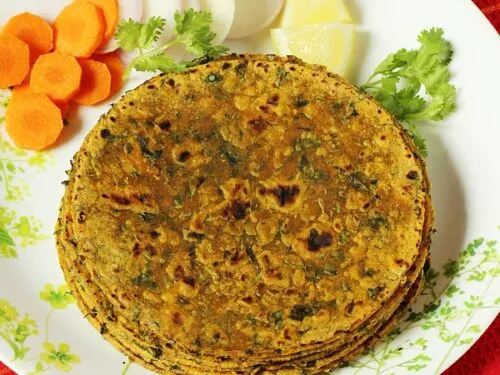
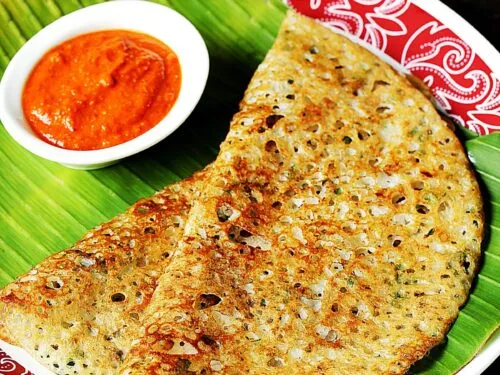
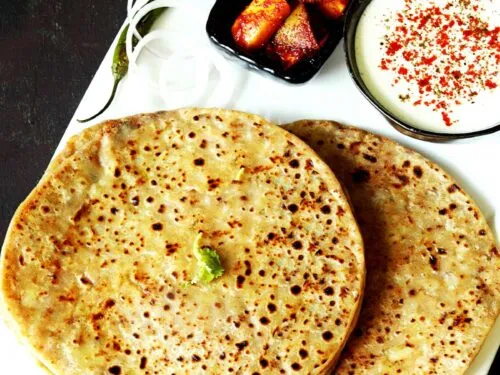
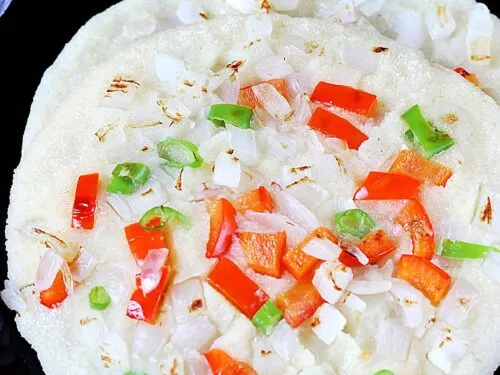
Comments
It was perfect. I was trying to make poha after 25-30 years, and had forgotten how to make. It came out superbly. Everyone liked it. Thank you!
So glad to know the recipe helped. Thank you
Lovely dadpe poha! Made it today and it was delish
Very good
Delicious Poha. Never bored with this and it is one of my favorites recipes from your website.
Your recipes are very helpful and this poha is a staple in my kitchen. Turns out perfect every single time
what percentage of batata poha is potato ?
in 1 kg raw poha how much potato should be added ?
For 1 kg poha, you can use about 250 to 300 grams potatoes.
Look to be “culturally authentic” recipes. thank you
It turned out so good!! Thank you for sharing recipe.
Sooo delicious.. thank you soo much
I am new to cooking and made this, it turned out extremely well! My whole family was impressed especially my wife!
This recipe is very helpful for me 😄 thank you
This has become a frequent breakfast for us, it is so delicious! Sometimes we stir in eggs near the end.
It really turned out great. Thanks.
I made the poha recipe you shared with viren. It turned out delicious. Thank you
Really great recipe, thanks for sharing.
Really great recipe, thanks for sharing
First attempt and no complaints. Got compliments “very delicious “.
Glad to know Pramodini
I like this poha recipe and have made it many times. Can you please teach me how to make masala poha with tomatoes and vegetables?
Hi,
Use the first recipe as is with 1 medium tomato (chopped or pureed). After sauteing the onions, saute ginger and cook the tomatoes until it becomes all mushy. Add carrots, peas, and bell pepper. Cover and cook until they soften. Add boiled potatoes, Stir in little pav bhaji masala or garam masala and chili powder. Sprinkle a few tablespoons water and add the softened poha. Steam as mentioned. This is tried and tested. Hope you like this.
I love your recipe. It’s now my go to recipe for Poha as a quick breakfast or snack option. ?
Thank you Manisha
I want to make Kanda poha for my breakfast for the train journey.I plan to cook it the previous evening . Will it last ? (A. C. Train)
Even if it keeps good due to the air con I don’t think you should eat it because poha is only steamed in the recipe and not cooked. It may cause stomach problem.
Made this for the first time; fantastic! I used a mixture of peanuts and cashews since I had both and used a mixture of peas and potatoes. Also increased seasoning just a bit. The recipe was easy to follow and spot on. Will definitely make this again. One question- can I scramble an egg or two in with the vegetables at the end just before adding the rice, or is that unheard of?
Hi Melanie,
Glad you like it. Yes egg in poha is an unheard thing. But I have done it a lot of times. During the lockdown we literally ate poha everyday and had to make different every time. Scramble the eggs first, spice it with salt and ground spices. Set aside. Stir into the hot steaming poha at the end. I’m sure you will love that.
🙂
Thanks. I plan on trying that for breakfast tomorrow. As I don’t have green chiles, can I substitute either dried red chilies or Kashmiri chili or some other type of chili powder?
Yes you can use both 2 dried red chilies and a little chilli powder but it won’t taste the same like green chilies. Stir in the chilli powder just before you add the soaked poha.